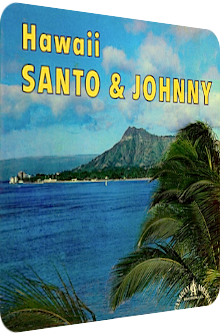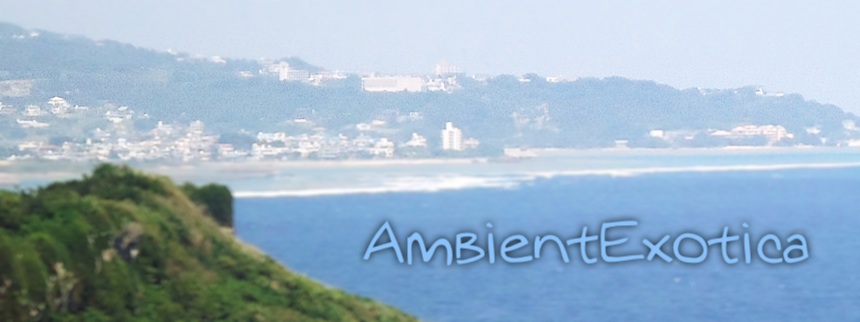
Santo & Johnny
Hawaii
1961
The good-looking guitar aficionados Santo & Johnny Farina were a pre-Beatles duo of Rock musicians who, since rough Rock was not technically invented yet, lacked the harder edge, but delivered traces of coolness and independence in their many songs and renditions, of which Sleep Walk from 1959 remains their greatest hit to this day. I am mentioning these potentially belittling facets because it remains – at least potentially – interesting to see whether the brothers' flimsily raucous inclemency makes its way into one of the sunniest, dreamiest and sugar-laden genres out there: Hapa Haole aka Hawaiian music.
At the peak of a holiday-related interest in Hawaii, with many an US denizen planning to visit the Golden Islands for the first time ever, Santo & Johnny succumb to the trend and release the aptly-titled Hawaii on Canadian-American Records in 1961. The usual 12 tracks are gathered on this album, most of them Hawaiian classics that have been heard in the Exotica genre numerous times before and ever since, but there is one marker which elevates this album and reduces the feeling of listening to an opportunistic work which is solely created to cash in and ride the wave of the latest fad: of the 12 songs, Santo & Johnny wrote three themselves, with one of them being an awe-inspiring piece of beautiful fragility and reduction, but more about this later. Hawaii sees Santo on his Fender steel guitar and Johnny on the acoustic guitar and ukulele. These instruments would be sufficient enough for a true-spirited Hapa Haole record, but there is another twist: the brothers are accompanied by the Hutch Davie Orchestra & Chorus. Brass instruments and strings encapsulate the strumming, the choir hums along in a kitschy way but is able to occasionally add that certain something to a tune. The orchestra is almost always audible yet discrete enough to neither outshine the brothers nor the gentleness of the original visions of the respective composer. Does this album have something worthwhile in store for Exotica fans? I'll tell you.
Lionel Newman's and Dorcas Cochran's Adventures In Paradise is as good a Hawaiian hymn as any to start a Hapa Haole-infused album. A closer look onto its melodic structure reveals a great compatibility with orchestral surroundings as well as instances of a more intimate coziness. Santo & Johnny unite both: an oooh-ooohing female choir offers a fitting susurration to Santo's spacey-acidic and at times electro piano-mimicking Fender steel guitar, short harp twangs increase the liquedous moisture of the arrangement whereas careful string undulations round off the theme. This would be your average Hawaiian ditty were it not for Santo's stylish Space-Age licks and tonal shifts on the steel guitar. The following Blue Hawaii by Leo Robin and Ralph Rainger finds the brothers and the Hutch Davie Orchestra in sun-dried beachscapes. The mixed choir oozes along, singing the title of the track time and again, a mellow trumpet à la Billy Vaughn joins, violins float in the background, but again, all of this would be worthless if the brother's gorgeous twangs were amiss. They play upfront, each chord is crunchy, vibrant and colorful with an even stricter focus on the dreaminess than before.
Dick and Bob Sherman's Pineapple Princess is next and the first uplifting ditty with a somewhat strangely de trop hillbilly motif played by Santo which is ennobled by Johnny's ukulele accompaniments, aquatic xylophone droplets and a sudden flourish of Mexican brass prowess. Traces of Aloha Oe are baked into the chorus, the ukulele trembles elastically, but nothing really fits, making Pineapple Princess a girl to avoid. It is Sea Shells that can be considered the first treat of the album, for it is written by the Farina brothers. Its slow Waltz structure with the steel guitar erections, rhythm ukulele and far-away strings is supercharged with syrup and yearning tones in minor, but finds a fitting foil in Santo's rather piercing, omnipresent licks. The occasional harp spirals augment the warmth. Hapa Haole worshippers will be pleased.
The fifth track is a surprise, for it is usually the last track of such LP's: Aloha Oe is the infamous song which is presented in the way it should be: as a schmaltzy ode. Spectral Aloha chants are clichéd to the maximum, the reverb of the pizzicato strings is delicate, but their backing melody is not, and Santo & Johnny try their best to cope with the situation, letting as much genteel energy flow into each twang as possible. Side A finishes with the genuinely languorous Reflections, a much better tune written by the brothers themselves. The tempo is more downbeat than ever, the decay and sustain of Santo's steel guitar live up to the track title and conflate with the backdrop of nullity, only carefully underpinned by Johnny's acoustic guitar sparkles. This one is truly enchanting, no orchestra or choir are disturbing the phantasmagoric aura. My top pick of the album, seemingly respectful of the Hawaiian culture while offering a laid-back, purposefully reduced approach. Dark yet gleaming. I really love it!
Side B opens in another surprising fashion. Say what you will, but Johnny Noble's version of Prince Leleiohaku's Hawaiian War Chant is always some sort of a benchmark on every Exotica album or related work: how will a conductor, arranger or band interweave the drum-heavy sections that were actually not used on the respective album heretofore? Turns out that Santo & Johnny and the Hutch Davie Orchestra go all-in on this one, unchaining heavy amounts of kettle drums, congas and double bass aortas, altogether devices that were not used on side A. Santo's work on the guitar is excellent, the strings are heavily whirling, ranging from threnodic scents to ebullient joy, the horns gleam, the backing choir is rather quiet but underlines the melodramatic jumpiness further. The more the song progresses, the more the exhilaration grows. A rather pumping track. Benchmark successfully accomplished!
While Charles E. King's Song Of The Islands unites harp glitters, a melting choir and Johnny's acoustic guitar with Santo's steel next of kin in order to widen the panorama of this hammock-friendly piece, Harry Owen's Sweet Leilani sees the sugar level increase due to transfiguring bum-bum and oooh-ooh chants in adjacency to Santo's otherwise scintillating guitar. The final harp spirals give this rendition a nice touch as well; it otherwise resides in uninspiring territories.
The duo considers Charles E. King for a second time, interweaving the Hawaiian Wedding Song into their album. The overarching scheme of this rendition can again best be described as deliberately reduced, but it never reaches the beautiful asceticism of the Farina's Reflections. Nevertheless, there are fissures and holes aplenty in this song which allow the lucency of each instrument to glow all the better. Santo's steel guitar is feisty and galactic as usual, but the soothing gallimaufry of harps, rose-tinted strings and solemn trumpets work quite well on this piece, and despite their amount, Hawaiian Wedding Song feels well-balanced and maintained. The penultimate Isle Of Dreams is the third and last unique cut by the Farinas. Offering a yellow-tinted sunscape in 3/4 time realized with Johnny's enormously mellow rhythm guitar, balmy brass instruments in the distance and Santo's washes of steel polyphony, the mood is carefree, mellifluous and silky with a short choir-kindled climax.
Clement Scott's and Dorothy Stewart's Now Is The Hour serves as the finale and lures the listener with its Bolero rhythm, Santo's warped riffs and Johnny's ukulele sprinkles. The choir is now strictly divided into male and female parts, singing the full portions of the lyrics. Murmuring strings oscillate in the background, gentle yet loud enough to make a difference. Despite the adamant focus on the choir, I feel curiously drawn to this tune. Neither over the top nor too whimsical, Now Is The Hour is a good closer of Santo's & Johnny's fleeting visit to that genre called Hapa Haole.
Hawaii is a double-edged sword, as most Hapa Haole albums are nowadays. Gyrating between the truthful spirits of this subgenre and a cooler pre-Rock'n Roll vibe, Santo & Johnny deliver skillful renditions of classic material as well as three unique compositions. My reserved feelings towards some of the chosen tracks arise from the specific timbre, effervescence and reductionistic chords of Hawaiian music, and I sometimes wonder how many people think of this genre as the real Exotica-related music, with everything else being all too fake and plastic. These trains of thoughts are indeed applicable and justified. Santo & Johnny remain in calm – and most importantly tested – waters which trickle into the textures and surfaces of their steel and acoustic guitars as well as the ukulele. Surprisingly enough, the Hutch Davie Orchestra & Chorus do fit very well in these fragile, amicable settings. The horns feel like snugly veils, the strings are merely scents, the choir hums along to the Polynesian mirages.
It is only Santo Farina who puts a bit of spice and verve into his tone sequences, but I will not exaggerate this perception, for you find these traces and clear nods to such a play style on many other related records, among them Harry Kaapuni & His Royal Polynesians' Aloha Hawaii (1960), Johnny Pineapple's Hawaiian Holiday (1965) and a lot of Don Tiare's works, to just mention a few. People who are not fond of this concept of Hawaiian music and rather enjoy the sound of Jazz quartets or the real symphonic counterparts with Hollywood strings and exotic percussion should stay away from Santo & Johnny's Hawaii… were it not for the gorgeous, almost nocturnal signature tune Reflections with its otherworldly reverb phases. Since the album has been remastered and is easily available on Amazon MP3, iTunes etc., you can easily check this particular gem out and see whether the rest suits your needs.
Exotica Review 207: Santo & Johnny – Hawaii (1961). Originally published on Apr. 27, 2013 at AmbientExotica.com.
